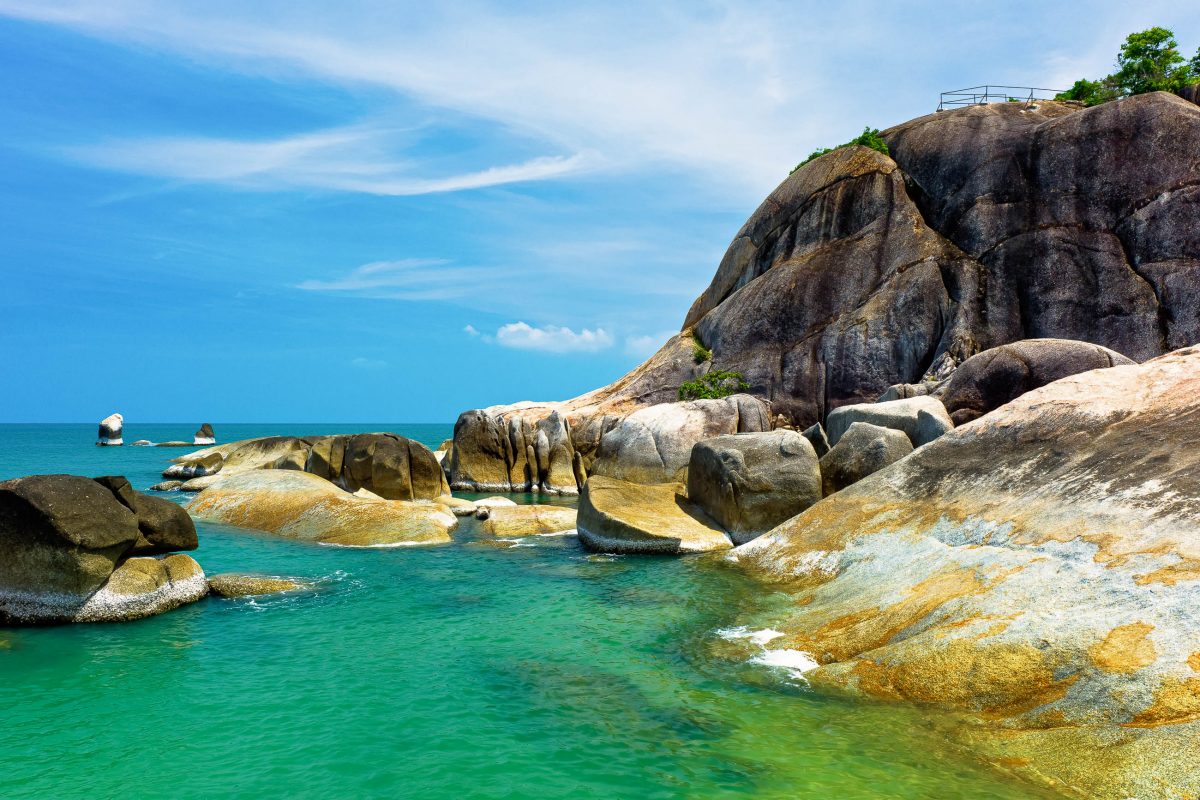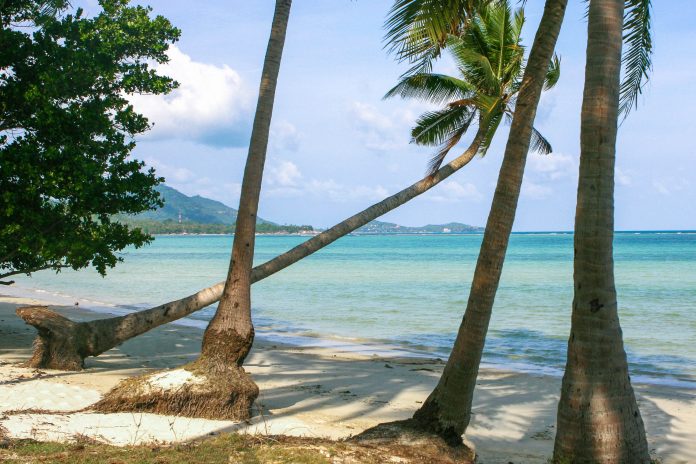Schneeweiße palmengesäumte Sandstrände, köstliche Gaumenfreuden aus dem glasklaren Meer, ein pulsierendes Nachtleben und Unterkünfte in allen Preisklassen machen die thailändische Insel Koh Samui zu einer Urlaubsinsel, wie sie besser nicht sein könnte.
Die weltbekannte Ferieninsel Koh Samui liegt im Golf von Thailand etwa 35 Kilometer vom thailändischen Festland entfernt und ist der Inbegriff einer perfekten Urlaubsinsel.
Inhaltsverzeichnis
Anreise nach Koh Samui
Koh Samui ist mit einer Fläche von 233 Quadratkilometern nach Koh Phuket und Koh Chang die drittgrößte Insel Thailands. Sie kann von Bangkok, Phuket und Krabi aus mit dem Flugzeug und von der Provinzhauptstadt Surat Thani auf dem Festland aus mit der Fähre erreicht werden.
Auch die nördlichen Nachbarinseln Phangan und Tao unterhalten Fährverbindungen zur Hauptstadt Na Thon. Um die Insel herum führt eine etwa 50km lange atemberaubende Ringstraße, auf der sich Kho Samui – am besten mit einem Motorroller, die so gut wie an jedem Strand zu günstigen Preisen vermietet werden – optimal entdecken lässt.
Tipp: Mietet man ein Auto, Motorrad oder Mofa auf Kho Samui, sollte man sich unbedingt vorher vom Zustand des Fahrzeugs überzeugen und im Zweifel lieber woanders hingehen. Auf Kho Samui herrscht außerdem Linksverkehr und für StVO-verwöhnte Europäer kann das Chaos auf Koh Samuis Straßen am Anfang recht gewöhnungsbedürftig sein.
Koh Samui – DAS Urlaubsparadies schlechthin
Koh Samui ist vor allem wegen seiner traumhaften, feinsandigen Strände und dem entspannten Lebensstil bekannt. Die Temperaturen von 30°C in der Luft und 28°C im Wasser machen Koh Samui zu einer absolut fantastischen Urlaubsinsel. Für Europäer ist die beste Reisezeit von Dezember bis Februar, da es hier noch am wenigsten heiß und schwül ist.
So gut wie jeder Strand in Koh Samui ist einen Besuch wert. Überall gibt es erstklassige Restaurants auszuprobieren und fantastische Korallenriffe zu entdecken.
Die schönsten Strände auf Koh Samui

Zu den beliebtesten Strandabschnitten gehören im Osten Chawaeng, der längste und schönste Sandstrand Koh Samuis mit der lebhaften Stadt „Chawaeng City“, DAS Touristenzentrum auf Koh Samui.
Der bei Surfern beliebte Strand Lamai endet in schroffen Granitfelsen. Hier findet sich auch Koh Samuis meistfotografierte steinerne Sehenswürdigkeit. Der Großmutterfelsen und der Großvaterfelsen sind aufgrund ihrer erstaunlichen Ähnlichkeit zum männlichen und weiblichen Geschlechtsorgan ein beliebtes Fotomotiv.
Im Norden liegen die Strände Bo Phut mit seinem charmanten ursprünglichen Dorf, durch das eine von Shops und Bungalows gesäumte Straße führt und das feinsandige Hufeisen des Mae Nam. Letzterer bietet einen spektakulären Blick auf die Nachbarinsel Koh Pha-ngan und ist die neue Heimat vieler Aussteiger und Expats. Hinter seinen Hügeln verbirgt sich Koh Samuis Weltklasse-Golf-Resort.
Die beiden Strände Taling Ngam und Lipa Noi im Westen sind für ihre atemberaubenden Sonnenuntergänge über den Inseln des nahegelegenen Angthong Marinepark bekannt, die sich von einem der zahlreichen exquisiten Fischrestaurants aus am besten genießen lassen. Der ruhigere Choeng Mon im Süden ist nicht direkt über die Ringstraße zu erreichen und somit Ziel von Urlaubern, die nicht das fröhliche Treiben Koh Samuis, sondern Ruhe und Entspannung suchen.
Sehenswertes auf Kho Samui abseits der Strände
Den perfekten Ort zum Relaxen findet man neben Kho Samuis Stränden auch in dem muslimischen Fischerdorf Hua Thanon. Inmitten von unberührter Natur und rauschenden Kokosnussplantagen scheint die Zeit stehen geblieben zu sein. Die Fischer fahren mit ihren prachtvoll bemalten Booten noch wie vor 50 Jahren aufs Meer und bieten ihren Tagesfang an den lokalen Märkten feil. Wer Koh Samuis ursprüngliche Kultur kennen lernen möchte, ist hier richtig.
Dschungel und Berge
Nicht nur die Küste von Koh Samui ist sehenswert. Das paradiesische Eiland hat auch abseits der traumhaften Strände einiges zu bieten. Das Landesinnere von Koh Samui war ursprünglich von dichtem Dschungel bedeckt, welcher aber, um Kokosnussplantagen zu schaffen, komplett abgeholzt wurde. Mittlerweile ist die Kalk- und Granit-Berglandschaft Koh Samuis wieder von Urwald überwuchert. Im Südwesten der Insel kann der mit 635m höchste Berg der Insel, der Khao Thai Kwai, bestiegen werden.
Buddhistische Tempel auf Koh Samui

Sehenswert sind auch die buddhistischen Tempel auf Kho Samui, wie zum Beispiel der goldene Chedi Laem So am Südkap der Insel oder der Wat Phra Yai auf der kleinen vorgelagerten Insel Ko Fan im Norden, in dem sich der Big Buddha von Koh Samui, eine 12 Meter hohe Buddhastatue befindet.
Vom Strand Bang Rak aus ist der Glanz der goldenen Statue gut zu bewundern, weswegen der Strand auch Big Buddha-Beach genannt wird. Tierliebhaber können Affen- uns Schlangen-Shows beiwohnen oder am oberen Ende des spektakulären Wasserfalls bei Na Mueang einen Ritt auf einem Elefanten versuchen.
Erste Besiedlung und Tourismus auf Koh Samui
Koh Samui war chinesischen Seefahrern und malaysischen Fischern schon lange bekannt. Immer wieder stoppten sie auf Koh Samui um Schiffe zu reparieren und ihre Trinkwasservorräte aufzufüllen. In einigen Schiffswracks vor der Küste wurden chinesische Keramiken aus dem 17. Jahrhundert gefunden.
Die ersten dauerhaften Siedler von der chinesischen Insel Hainan und dem thailändischen Festland ließen sich im 18. Jahrhundert auf Koh Samui nieder, später kamen zu den Buddhisten auch noch thailändische Muslime dazu.
Die Mischung aus mehreren Ethnien und Religionen auf Koh Samui führte zu einem ganz eigenen Selbstbewusstsein der Bevölkerung von Koh Samui, die sich selbst nicht als Thai, sondern als „Chao Samui“ („Volk von Samui“) sehen. Sie leben vor allem vom Fischfang und von der Verarbeitung und vom Export von Kokosnüssen, die als die besten Thailands gelten.
Seit den 1970ern erlebte der Tourismus in Koh Samui einen starken Aufschwung. Sie wurde von den Aussteigern des Westens für sich entdeckt und war ähnlich wie Goa in Indien oder Bali in Indonesien vor allem für Hippies ein beliebtes Ziel. Im Lauf der 1980er Jahre wurde die Infrastruktur nach und auf Koh Samui massiv ausgebaut, 1989 wurde der Flughafen eröffnet, über den Koh Samui in einer guten Stunde von Bangkok aus zu erreichen ist.
Damit war das Tor Koh Samuis für den Massentourismus geöffnet. Dem wurde durch mehrere Restriktionen versucht, Einhalt zu gebieten. So darf zum Beispiel auf Koh Samui nur „palmenhoch“ gebaut werden, was eine Errichtung von höheren als zweistöckigen Gebäuden verhindert. Dennoch gibt es auf dem paradiesischen Eiland Unterkunftsmöglichkeiten in jeder Preisklasse, von der einfachen Hütte bis zum Luxushotel.
Schattenseiten des Tourismus auf Koh Samui
Der Einzug des Massentourismus in Koh Samui brachte für die Natur auf der Insel und vor allem für die einheimische Bevölkerung Nachteile mit sich. Viele Einwohner des Atolls klagen, dass sie ihr Land an ausländische Investoren verloren haben. Die Qualität des Trinkwassers hat sich verringert, der Verkehr auf der Ringstraße rund um die Insel hat deutlich zugenommen und die Preise für Lebensmittel sind innerhalb weniger Jahre um 300% gestiegen.
Der üppige Gürtel der Kokospalmen, der früher die gesamte Insel gesäumt hat, musste mittlerweile an vielen Stellen gepflasterten Strandwegen, Bungalows und langgezogenen Hotelanlagen weichen. Auch die Korallenriffe rund um Koh Samui haben bereits starke Schäden davongetragen.





